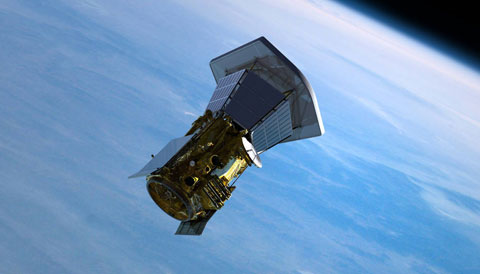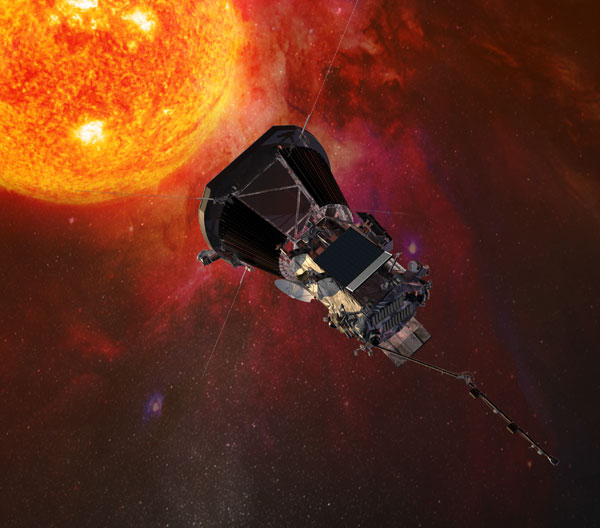NASA's Parker Solar Probe, set to launch in 2018, will be humanity's first effort to "touch the Sun," revolutionizing our understanding of the Sun's corona, the solar wind, and the greater heliosphere.

JHU / APL
NASA has announced that they are retitling the Solar Probe Plus, humanity's first mission to the outer layers of the Sun, the Parker Solar Probe. The new name honors astrophysicist Eugene Parker, whose years' of work in the field known as "space weather" have helped us understand the interactions between stars and their orbiting bodies.
Eugene Parker
In the latter half of the 1950s, a young professor teaching astronomy and physics at the University of Chicago's Enrico Fermi Institute, Eugene Parker, published an article in the Astrophysical Journal entitled "Dynamics of the interplanetary gas and magnetic fields." The paper introduced the idea of a wind emanating from the Sun, a concept so controversial that two reviewers rejected the paper. In the end, it was only published because Subrahmanyan Chandrasekhar, the journal's science editor at the time (and no stranger himself to rejection for revolutionary thinking), overruled the reviewers' decisions.
Much of Parker's work at the time focused on the Sun's radiation and its potential effects on the planets. In his 1958 paper, Parker hypothesized that there was a constant stream of high-energy particles and radiation escaping from the surface of the Sun, an idea that ran contrary to the accepted view of the time that this space contained only a vacuum. But it was controversial only for a little while — in 1962 Mariner 2 confirmed the existence of the solar wind.
En Route to the Sun

Johns Hopkins University Applied Physics Laboratory
While observations proved the solar wind existed, they weren't able to fully answer how or why the Sun's tenuous outer atmosphere, or corona, should sear at a temperature of millions of degrees. The Sun's visible surface, after all, is only several thousand degrees, so something must be heating the matter farther from the Sun, but scientists have long debated what that process could be. The Parker Solar Probe will address that fundamental question, completing seven flybys of Venus between 2018 and 2024 to slowly spiral into orbits that take it within 3.9 million miles (9 solar radii) of the Sun.
At its closest approach, the spacecraft will hurtle around the Sun at 430,000 mph (200 kilometers per second) at a distance nearly ten times closer to the Sun than Mercury (on average), and seven times closer than any spacecraft has ever come before. The probe will perform its scientific investigations in a region of intense heat and radiation, and its instruments must thereby be protected by a 4.5-inch thick carbon-composite heat shield, able to withstand temperatures of up to 2,500°F.
Principal Investigations
The mission's main goal is to trace heat and energy flow through the corona and explore what causes charged particles to accelerate away from the surface of the Sun. To that end, the instrument aboard the Parker Solar probe will study every aspect of the Sun from its magnetic and electric fields to the solar wind.
- The FIELDS instrument consists of five voltage sensors as well as three magnetometers, sensors which measure magnetic field. It will make detailed measurements of the corona's electric and magnetic fields, as well as other gauging electron temperature and plasma density.
- The ISIS instrument will observe solar energetic particles (SEPs) such as electrons, protons, and heavy ions accelerated to energies as high as 100 MeV, correlating these particles with larger coronal structures and the solar wind.
- WISPR, a wide field telescope imager, will supplement the raw data captured by the FIELDS and ISIS instruments with high-quality photographs.
- SPAN-A+ and SPAN-B will measure the velocity, temperature, and density distributions of the electrons, protons, and helium ions.
Together, these instruments will help unlock the answers to the Sun's most puzzling questions — all the while helping to protect a society that is becoming increasingly dependent on satellites and other technology vulnerable to the threats of space weather.
 2
2









Comments
Peter Hannah
June 12, 2017 at 7:11 am
Very interesting, but I think you mean "Principal Investigations".
Must keep editorial standards up!
You must be logged in to post a comment.
Monica Young
June 12, 2017 at 9:56 am
Fixed, and thanks for the catch!
You must be logged in to post a comment.
You must be logged in to post a comment.